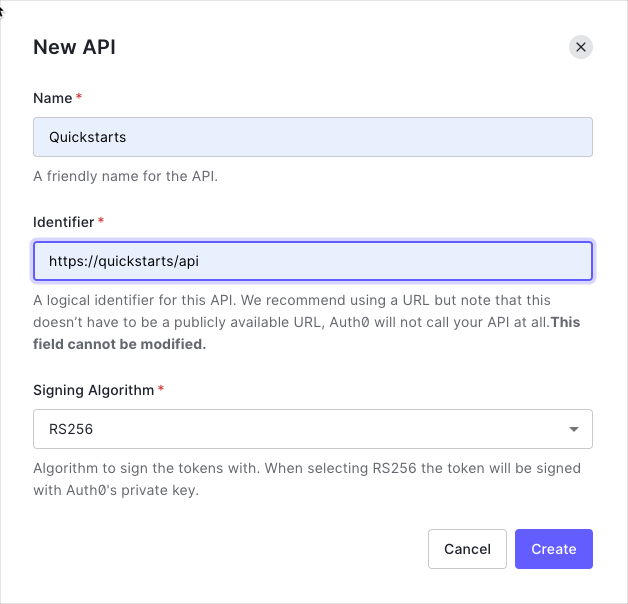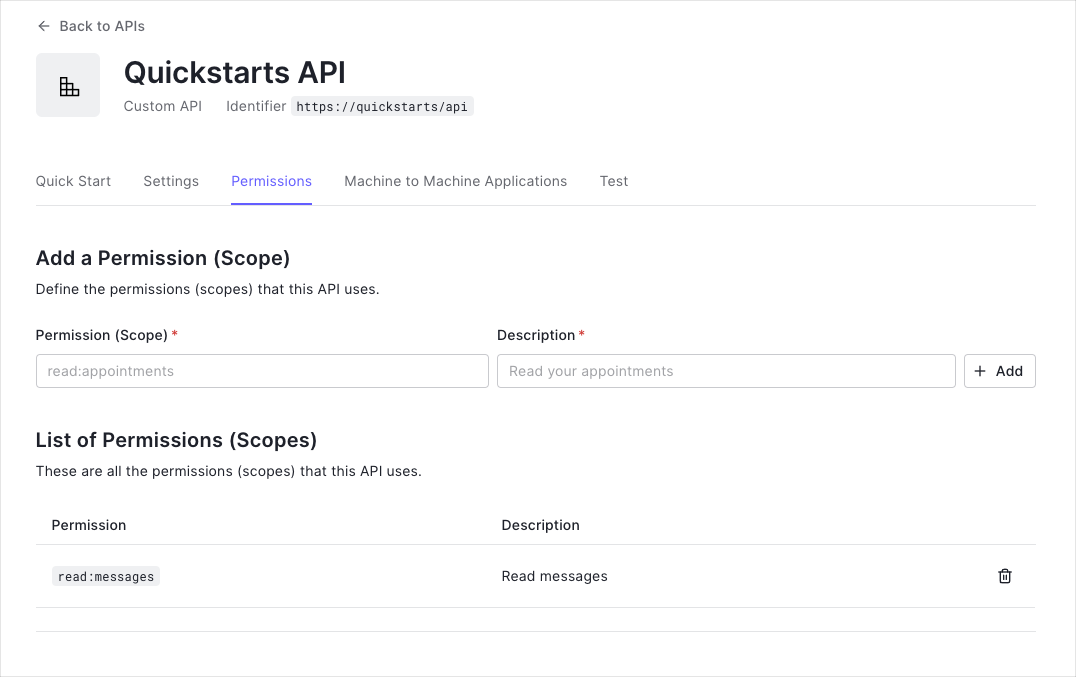Python API: Authorization
This tutorial demonstrates how to add authorization to a Python API built with Flask. We recommend that you log in to follow this quickstart with examples configured for your account.
I want to integrate with my app
15 minutesI want to explore a sample app
2 minutesGet a sample configured with your account settings or check it out on Github.
Configure Auth0 APIs
Create an API
In the APIs section of the Auth0 dashboard, click Create API. Provide a name and an identifier for your API, for example, https://quickstarts/api. You will use the identifier as an audience later, when you are configuring the Access Token verification. Leave the Signing Algorithm as RS256.

By default, your API uses RS256 as the algorithm for signing tokens. Since RS256 uses a private/public keypair, it verifies the tokens against the public key for your Auth0 account. The public key is in the JSON Web Key Set (JWKS) format, and can be accessed here.
Define permissions
Permissions let you define how resources can be accessed on behalf of the user with a given access token. For example, you might choose to grant read access to the messages resource if users have the manager access level, and a write access to that resource if they have the administrator access level.
You can define allowed permissions in the Permissions view of the Auth0 Dashboard's APIs section.

This example demonstrates:
-
How to check for a JSON Web Token (JWT) in the
Authorizationheader of an incoming HTTP request. -
How to check if the token is valid, using the JSON Web Key Set (JWKS) for your Auth0 account. To learn more about validating Access Tokens, see Validate Access Tokens.
Validate Access Tokens
Install dependencies
Add the following dependencies to your requirements.txt:
# /requirements.txt
flask
python-dotenv
python-jose
flask-cors
sixWas this helpful?
Create a Flask application
Create a server.py file and initialize the Flask application. Set the domain, audience and the error handling.
# /server.py
import json
from six.moves.urllib.request import urlopen
from functools import wraps
from flask import Flask, request, jsonify, _request_ctx_stack
from flask_cors import cross_origin
from jose import jwt
AUTH0_DOMAIN = '{yourDomain}'
API_AUDIENCE = YOUR_API_AUDIENCE
ALGORITHMS = ["RS256"]
APP = Flask(__name__)
# Error handler
class AuthError(Exception):
def __init__(self, error, status_code):
self.error = error
self.status_code = status_code
@APP.errorhandler(AuthError)
def handle_auth_error(ex):
response = jsonify(ex.error)
response.status_code = ex.status_code
return responseWas this helpful?
Create the JWT validation decorator
Add a decorator which verifies the Access Token against your JWKS.
# /server.py
# Format error response and append status code
def get_token_auth_header():
"""Obtains the Access Token from the Authorization Header
"""
auth = request.headers.get("Authorization", None)
if not auth:
raise AuthError({"code": "authorization_header_missing",
"description":
"Authorization header is expected"}, 401)
parts = auth.split()
if parts[0].lower() != "bearer":
raise AuthError({"code": "invalid_header",
"description":
"Authorization header must start with"
" Bearer"}, 401)
elif len(parts) == 1:
raise AuthError({"code": "invalid_header",
"description": "Token not found"}, 401)
elif len(parts) > 2:
raise AuthError({"code": "invalid_header",
"description":
"Authorization header must be"
" Bearer token"}, 401)
token = parts[1]
return token
def requires_auth(f):
"""Determines if the Access Token is valid
"""
@wraps(f)
def decorated(*args, **kwargs):
token = get_token_auth_header()
jsonurl = urlopen("https://"+AUTH0_DOMAIN+"/.well-known/jwks.json")
jwks = json.loads(jsonurl.read())
unverified_header = jwt.get_unverified_header(token)
rsa_key = {}
for key in jwks["keys"]:
if key["kid"] == unverified_header["kid"]:
rsa_key = {
"kty": key["kty"],
"kid": key["kid"],
"use": key["use"],
"n": key["n"],
"e": key["e"]
}
if rsa_key:
try:
payload = jwt.decode(
token,
rsa_key,
algorithms=ALGORITHMS,
audience=API_AUDIENCE,
issuer="https://"+AUTH0_DOMAIN+"/"
)
except jwt.ExpiredSignatureError:
raise AuthError({"code": "token_expired",
"description": "token is expired"}, 401)
except jwt.JWTClaimsError:
raise AuthError({"code": "invalid_claims",
"description":
"incorrect claims,"
"please check the audience and issuer"}, 401)
except Exception:
raise AuthError({"code": "invalid_header",
"description":
"Unable to parse authentication"
" token."}, 401)
_request_ctx_stack.top.current_user = payload
return f(*args, **kwargs)
raise AuthError({"code": "invalid_header",
"description": "Unable to find appropriate key"}, 401)
return decoratedWas this helpful?
Validate scopes
Individual routes can be configured to look for a particular scope in the Access Token by using the following:
# /server.py
def requires_scope(required_scope):
"""Determines if the required scope is present in the Access Token
Args:
required_scope (str): The scope required to access the resource
"""
token = get_token_auth_header()
unverified_claims = jwt.get_unverified_claims(token)
if unverified_claims.get("scope"):
token_scopes = unverified_claims["scope"].split()
for token_scope in token_scopes:
if token_scope == required_scope:
return True
return FalseWas this helpful?
Protect API Endpoints
The routes shown below are available for the following requests:
GET /api/public: available for non-authenticated requestsGET /api/private: available for authenticated requests containing an access token with no additional scopesGET /api/private-scoped: available for authenticated requests containing an access token with theread:messagesscope granted
You can use the decorators and functions define above in the corresponding endpoints.
# Controllers API
# This doesn't need authentication
@APP.route("/api/public")
@cross_origin(headers=["Content-Type", "Authorization"])
def public():
response = "Hello from a public endpoint! You don't need to be authenticated to see this."
return jsonify(message=response)
# This needs authentication
@APP.route("/api/private")
@cross_origin(headers=["Content-Type", "Authorization"])
@requires_auth
def private():
response = "Hello from a private endpoint! You need to be authenticated to see this."
return jsonify(message=response)
# This needs authorization
@APP.route("/api/private-scoped")
@cross_origin(headers=["Content-Type", "Authorization"])
@requires_auth
def private_scoped():
if requires_scope("read:messages"):
response = "Hello from a private endpoint! You need to be authenticated and have a scope of read:messages to see this."
return jsonify(message=response)
raise AuthError({
"code": "Unauthorized",
"description": "You don't have access to this resource"
}, 403)Was this helpful?